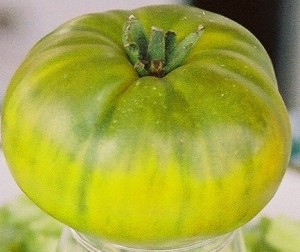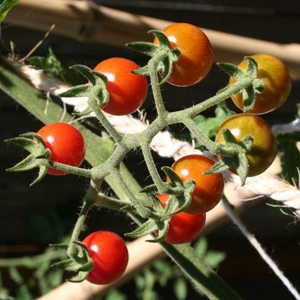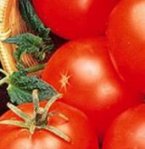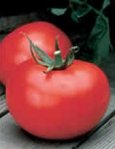Finding the Best Tomato Variety Is Hard
There are literally hundreds of varieties of tomato available either as seedlings at the garden center or as seeds from either the garden center or from a mail order or Internet company. Choosing the best variety for you can be an intimidating and certainly a challenging task.
List of Best Seed Catalogs For Tomatoes
Tomato Bob’s Heirloom Tomatoes
Choosing This Year’s Tomatoes
Now is a good time to choose and make a list of the kinds of tomatoes you will be growing in your garden this summer. There are literally hundreds of varieties available, but unfortunatley not every one will do well in your garden.
So the name of the game is to find those varieties that work well in your neighborhood. The best source are those tomato gardeners living in your county. If a variety works for them, it will likely be good for you.
Good Source of Info On Tomato Varieties
For excellent info on the best Tomato varieties by state and county go to the vegetable variety data collection project at Cornell University –www.vegvariety.cce.cornell.edu. [link] We urge you to join this valuable site and contribute your own ratings of varieties.
Finding the Best Tomato Variety
There are literally hundreds of varieties of tomatoes available either as seedlings at the garden center or as seeds from either the garden center or from a mail order or Internet company. Choosing the best variety for you may seem daunting Here are the main variables used by some tomato gardeners in making their choices
There are two kinds of tomato plants – determinant and indeterminant.
The shorter determinant plants grow only to about 3 or 4 feet and produce their crop and ripen within a few weeks. A tomato cage serves as support.
The much taller indeterminent tomato will grow to over 7 feet andwill need a proper trellis as they continue to produce tomatoes through frost. Search “Vertical Growing” on our website (yardener.com) for info about rigging vertical supports for tomatoes.
Early Harvest vs Mid-season and Late Season Varieties
Some varieties of tomato ripen earlier in the season, around early July while others take longer to ripen. Size is often the distinguishing factor. Early varieties, are usually more tolerant of cold temperatures.
Here in my zone 5 Michigan garden, Early Girl and Burpee 4th of July are staples I plant every year. I have found them to be dependable producers, regardless of the weather conditions.
Slicing tomato (conventional size) vs. Beefsteak (big) Tomato,
Here you are deciding if you want a normal size tomato or one or more of the really big tomatoes often called “beefsteak”. If you love tomatoes in sandwiches a beefsteak tomato gives you the perfect slice for a sandwich.
Sauce Tomato
For the cooks in the crowd, a sauce tomato is bred to be used in making tomato sauces, however, many folks love to eat the fresh in salads and salsas. Rutgers, an indeterminate, bred for use as a canning tomato is also prized by many as a slicer. Amish paste and Romas are preferred for paste and sauces.
Cherry Tomato (small)
Cherry tomatoes are usually the size of a big grape. They come in colors including red, orange, pink, mahogany and green. Some folks eat them like candy any time during the day. Cherry tomatoes are good for salads because they are already bite-sized. My all time favorite is the Sun Gold pictured on the left. It is sweet but tangy and the bush produces hundreds of orange fruits.
Heirloom vs. Hybrid
Open-pollinated varieties produce offspring that are true to type, meaning they have the same characteristics of the parent plant. Heirlooms are open-pollinated varieties that have been passed down through generations of farmers and gardeners. Hybrids are a cross between two genetically different plants. Seeds saved from hybrids are often sterile, and even if they are viable, they will not be true to type. This means you must buy new hybrid seed every year or two.
Lots of Colors
You name it, tomatoes come in many different colors. Back in Grandma’s day most tomatoes were simply red. Now you can get varieties that are Red, Pink, Orange, Yellow, Green, Purple, and even Striped.
Seed vs. Seedling or Transplants
If you buy seeds for your tomatoes you will have many more choices of variety but you will have to start those plants indoors before setting them outside in the garden. Years ago, the only place to buy tomato transplants ready to plant in the soil was the local garden center. The garden center still offers seedlings but now many seed houses are also selling tomato transplants through the mail. One advantage with buying your tomato seedlings from your local garden center, is that they will know which varieties should do well in your area.
Some Seed Companies With Good Selection of Tomatoes
Burpee Seed Company; seeds and seedlings; www.burpee.com
Johnny’s Selected Seeds, seeds ; www.johnnyseeds.com
Seeds of Change; seeds; www.seedsofchange.com
Nichols Garden Nursery, seeds, www.nicholsgardennursery.com
Tomato Growers Supply Company; seeds; www.tomatogrowers.com
Victory Seed Company; seed; www.tomatoseed.com
Totally Tomato Company; seed; www.totallytomato.com
Choosing Heirloom Tomatoes
Heirloom or heritage tomatoes are all the rage these days. These old fashioned varieties come in all sizes, shapes and colors. The term heirloom is used for tomato cultivars that are open pollinated and are 40 years old or more. There are hundreds of varieties available today so choosing the best varieties, those that taste best and grow best in your area can be a challenge.
The downside to heirlooms is they are not a disease tolerant as the modern day hybrids and they are not as productive. But if you have the space, they are well worth the effort.
Different color tomatoes have different taste qualities, so that’s one way to start the selection search. Green tomatoes tend to have a bit of tang to them. And yes they are green when ripe, but usually develop slightly yellow or yellowish pink shoulders. Purple tomatoes are said to have a complex flavor, while yellow, which are lower in acid are more mild.
Another method of choosing tomato cultivars is selecting tomatoes that were developed in areas with similar weather conditions as yours. Tomatoes developed to grow in the heat of the South may not do as well or taste as good as those that originated in the North, if you are a cold weather gardener. Many tomato catalogs give the plant origins of the seeds they sell or designate whether the seeds do best in hot or cold climates.
Every year I pick a cultivar or two I have never grown, always on the search for the “best of the best.” Last year, here in Michigan we experience wet cold weather all season and my entire tomato crop, with the exception of Matt’s Wild Cherry, tasted terrible. This season I am planning to “tent” my tomatoes if we have excessive rain. Stay tuned.
Over the years I have tried a number of heirlooms and some have become staples in my garden.
 Bonny Best – a medium red with real tomato taste – early
Bonny Best – a medium red with real tomato taste – early
 Black from Tula – from the Ukraine, rich complex flavor 80 to 85 days
Black from Tula – from the Ukraine, rich complex flavor 80 to 85 days
 Evergreen- 75 days - large tomato with rich flavour – big time favorite of mine.
Evergreen- 75 days - large tomato with rich flavour – big time favorite of mine.
 Last year I grew Matt’s wild cherry, a current size heirloom tomato with incredible flavor. It’s a great way to get kids to eat tomatoes, as they love picking these tiny morsels off the vines and popping them in their mouths.
Last year I grew Matt’s wild cherry, a current size heirloom tomato with incredible flavor. It’s a great way to get kids to eat tomatoes, as they love picking these tiny morsels off the vines and popping them in their mouths.
Bonnie Best tomato plants can be found in garden centers. Black from Tula and Evergreen are usually have to be grown from seed. Google their names for seed sources.










